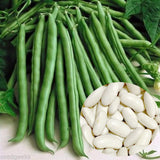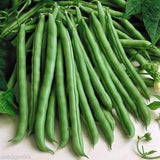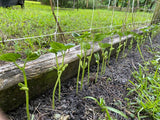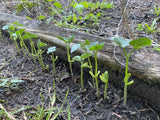70 Blue Lake Pole Bean Seeds Stringless Heirloom
(Phaseolus vulgaris) Blue Lake Pole Beans are known for reliability, disease resistance, flavor and high yields, the Blue Lake Pole Bean produces vigorous vines up to 7' tall. Excellent for canning, freezing, or eating fresh. White seeded, mosaic virus resistant. Will produce a very high yield of stringless, dark-green, 6 – 7 inch pods that are straight and smooth.
All Seeds Come In A 2X3 Resealable Plastic Zip Lock Bag, Shipped In A Protective Bubble Mailer. If You Have Any Questions You Can Message Us At Any Time. Shipping Time Is Usually Between 1 And 10 Business Days. All multiple orders of the same seed are put in the same bag. For example if you order 500 beefsteak tomato seeds x 3 then 1500 seeds will be put in the same bag. We do not send out 3 individual bags with 500 in each. This goes for all seeds unless they are listings of different seeds.
Pole and bush beans (more commonly called green beans) are a tender vegetable and a great addition to any garden, great eaten fresh off the plant or incorporated into a recipe. Bush beans require less maintenance, so they are easier to grow.
PLANTING
Pole beans will grow in a climbing vine and require a trellis or staking. Bush beans will spread up to 2 feet but do not require support.
Do not start seeds indoors; they may not survive transplanting.
Seeds can be sown outdoors anytime after last spring frost, minimum soil temp is 48 degrees F. Plant 1 inch deep, a little deeper for sandier soils. Cover soil to warm if necessary.
Bush beans: Plant 2 inches apart.
Pole beans: Set up trellises, or “cattle panels,” and plant 3 inches apart.
If you like pole beans, an easy support for them is a “cattle panel”—a portable section of wire fence—16 feet long and 5 feet tall. The beans will climb with ease, and you won’t have to get into contorted positions to pick them.
For a harvest that lasts all summer, sow beans every 2 weeks. If you’re going to be away, skip a planting. Beans do not wait for anyone..
Rotate crops each year.
PLANT CARE
Mulch soil to retain moisture; make sure that it is well-drained.
Water regularly, from start of pod to set. Water on sunny days so foliage will not remain soaked.
Beans require normal soil fertility. Only fertilize where levels are low. Begin after heavy bloom and set of pods.
Use a light hand when applying high-nitrogen fertilizer, or you will get lush plants and few beans.
Weed diligently and use shallow cultivation to prevent disturbing the root systems.
PESTS/DISEASES
Aphids
Mexican Bean Beetles
Japanese Beetles
White Mold
Mosaic Viruses
Bean blossoms will drop from the plant if the weather is too hot and too much nitrogen in the soil will prevent pods from setting.
HARVEST/STORAGE
Beans are picked at an immature stage, when the seeds inside have not yet fully developed.
Look for firm, sizable pods and snap or cut off the plant. Do not tear the plant.
Store beans in a moisture-proof, airtight container in the refrigerator. Beans will toughen over time even when stored properly.
Beans can be kept fresh for about 4 days, or blanched and frozen immediately after harvesting.
Beans can also be canned or pickled.
All Seeds Come In A 2X3 Resealable Plastic Zip Lock Bag, Shipped In A Protective Bubble Mailer. If You Have Any Questions You Can Message Us At Any Time. Shipping Time Is Usually Between 1 And 10 Business Days. All multiple orders of the same seed are put in the same bag. For example if you order 500 beefsteak tomato seeds x 3 then 1500 seeds will be put in the same bag. We do not send out 3 individual bags with 500 in each. This goes for all seeds unless they are listings of different seeds.
Pole and bush beans (more commonly called green beans) are a tender vegetable and a great addition to any garden, great eaten fresh off the plant or incorporated into a recipe. Bush beans require less maintenance, so they are easier to grow.
PLANTING
Pole beans will grow in a climbing vine and require a trellis or staking. Bush beans will spread up to 2 feet but do not require support.
Do not start seeds indoors; they may not survive transplanting.
Seeds can be sown outdoors anytime after last spring frost, minimum soil temp is 48 degrees F. Plant 1 inch deep, a little deeper for sandier soils. Cover soil to warm if necessary.
Bush beans: Plant 2 inches apart.
Pole beans: Set up trellises, or “cattle panels,” and plant 3 inches apart.
If you like pole beans, an easy support for them is a “cattle panel”—a portable section of wire fence—16 feet long and 5 feet tall. The beans will climb with ease, and you won’t have to get into contorted positions to pick them.
For a harvest that lasts all summer, sow beans every 2 weeks. If you’re going to be away, skip a planting. Beans do not wait for anyone..
Rotate crops each year.
PLANT CARE
Mulch soil to retain moisture; make sure that it is well-drained.
Water regularly, from start of pod to set. Water on sunny days so foliage will not remain soaked.
Beans require normal soil fertility. Only fertilize where levels are low. Begin after heavy bloom and set of pods.
Use a light hand when applying high-nitrogen fertilizer, or you will get lush plants and few beans.
Weed diligently and use shallow cultivation to prevent disturbing the root systems.
PESTS/DISEASES
Aphids
Mexican Bean Beetles
Japanese Beetles
White Mold
Mosaic Viruses
Bean blossoms will drop from the plant if the weather is too hot and too much nitrogen in the soil will prevent pods from setting.
HARVEST/STORAGE
Beans are picked at an immature stage, when the seeds inside have not yet fully developed.
Look for firm, sizable pods and snap or cut off the plant. Do not tear the plant.
Store beans in a moisture-proof, airtight container in the refrigerator. Beans will toughen over time even when stored properly.
Beans can be kept fresh for about 4 days, or blanched and frozen immediately after harvesting.
Beans can also be canned or pickled.













